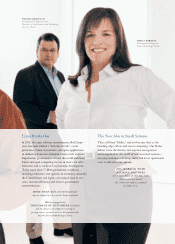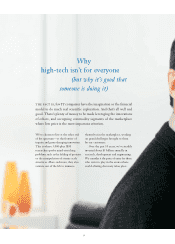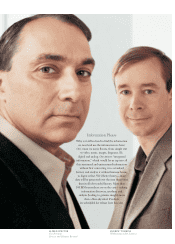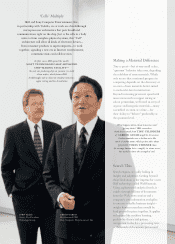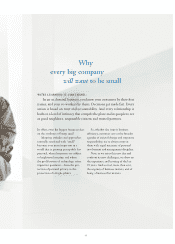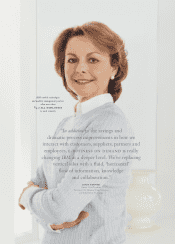IBM 2002 Annual Report Download - page 34
Download and view the complete annual report
Please find page 34 of the 2002 IBM annual report below. You can navigate through the pages in the report by either clicking on the pages listed below, or by using the keyword search tool below to find specific information within the annual report.
Sweating the Small Stuff
The quest is always to get more with
less. More processing power,
more storage, but less electrical power,
running at lower temperatures and
created at lower cost. So physicists
probe the unimaginably small realms
of nanotechnology
—
finding alternatives
to traditional silicon and building the
tools to work at the level of atomic
structures, paving the way for capabilities
that we can’t yet imagine. The potential
size of silicon transistors was reduced
by a factor of 10 in 2002, with the
creation of a transistor measuring just
six nanometers.
Imagine a high-density storage device capable of
holding a trillion bits of information—the
equivalent of 25 million textbook pages of data—
on something the size of a postage stamp.
It’s code-named “millipede”for its thousands
of nano-size “feet” (or tips), used to punch
single-bit indentations into plastic film.
Lab Meets World
On Demand Innovation Services, a new unit we
formed in 2002, combines the talents of
IBM Research with our Business Consulting Services
experts to bring our researchers into a whole
new type of “lab.” They’re working in the marketplace
on some of our customers’ most pressing challenges,
and bringing those real-world problems back into
the traditional lab to be solved with new technology.
As our scientists spread their wings (and their
impact) as consultants, On Demand Innovation
Services will become a primary channel for bringing
the fruits of our investment in research directly
to our customers.
peggy kennelly
Vice President
On Demand Innovation Services
What Is Life?
What began as a grand challenge for
computer scientists will, when completed,
have meaning for all humanity. And
its pursuit has led IBM to a market that
represents one of the fastest-
growing
segments of the global IT industry.
When
IBM launched a $100 million project
to build a supercomputer to fathom
the intricacies of protein folding in
humans, we’d crossed the
threshold
of exploration into personalized
medicines, more precise diagnoses and
new insight into disease and prevention.
Today, our life sciences business
includes more
than 1,000 employees—
bioinformaticians,
biologists, chemists
and computer scientists. They’re
forging
partnerships with leading-edge
organizations
like Aventis, deCODE
genetics, Celera Genomics and
the Mayo Clinic to transform drug
discovery and development, and deliver
information-based medicine.
32









